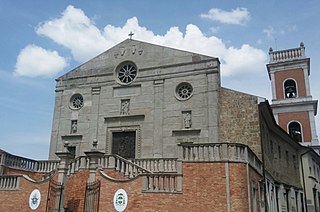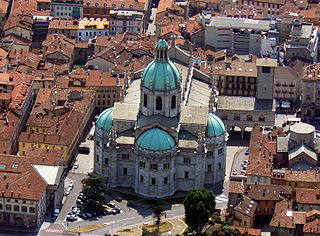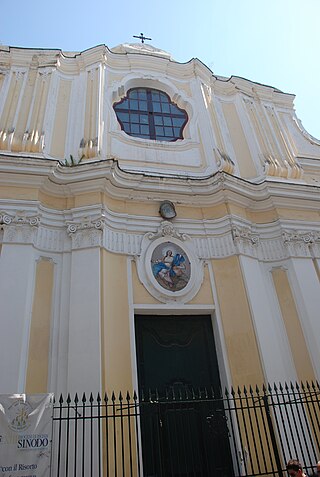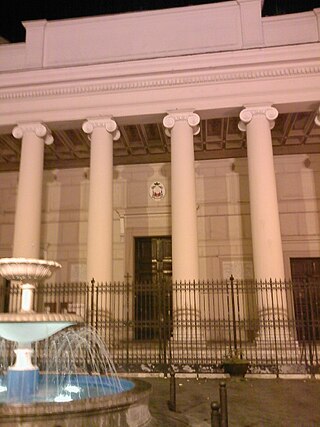
The Archdiocese of Ancona–Osimo is a Latin Church ecclesiastical territory and metropolitan see of the Catholic Church in the Marche region of Italy.

The Diocese of Nardò-Gallipoli is a Latin diocese of the Catholic Church in southern Italy. It is a suffragan of the Archdiocese of Lecce.

The Roman Catholic Diocese of Ferentino existed until 1986, when it was united into the new diocese of Frosinone-Veroli-Ferentino.

The Diocese of Bovino is a Latin Church diocese of the Catholic Church in the civil province of Apulia, southern Italy. It is 23 mi (37 km) southwest of Foggia. It was established in the tenth century, and was a suffragan of the archdiocese of Benevento. In 1986 it was merged into the Archdiocese of Foggia-Bovino. In 1980, the diocese claimed 23,500 adherents, served by 26 priests.

The Diocese of Ariano Irpino-Lacedonia is a Latin diocese of the Catholic Church. It is a suffragan of the Archdiocese of Benevento.

The Diocese of Avellino is a Latin diocese of the Catholic Church in the territory of the Irpini, some 55 km (30 mi) east of Naples and 23 km (14 mi) south of Benevento, in the modern Republic of Italy. It is suffragan to the archdiocese of Benevento. The bishop of Avellino, along with the bishop of S. Agata de' Goti, had the privilege, recognized at the provincial synod of 1654, of being summoned to attend upon the death and obsequies of the archbishop of Benevento.

The Diocese of Orvieto-Todi is a Latin Church ecclesiastical territory or diocese of the Catholic Church in central Italy. It was created in 1986 when the historical Diocese of Orvieto was united to the Diocese of Todi. The Diocese of Orvieto-Todi is immediately exempt to the Holy See and not part of any ecclesiastical province.

The Diocese of Como is a Latin Church ecclesiastical jurisdiction or diocese of the Catholic Church in northern Italy. It was established in the Fourth Century. It is a suffragan diocese in the ecclesiastical province of the metropolitan Archdiocese of Milan. The Bishop of Como's cathedra is in the Como Cathedral.

The Archdiocese of Crotone-Santa Severina is a Latin Church diocese of the Catholic Church in Calabria in southern Italy, created in 1986 when it was combined with the Diocese of Santa Severina. It is now a suffragan of the Archdiocese of Catanzaro-Squillace. In 2013 there was one priest for every 1,841 Catholics.

The Diocese of Ascoli Piceno is a Latin diocese of the Catholic Church in the Marche. It has existed since the fourth century. Historically immediately dependent on the Holy See, it is now a suffragan of the Archdiocese of Fermo. There is, in 2015, one priest for every 1,074 Catholics.

The diocese of Teano-Calvi is a Latin diocese of the Catholic Church in Campania, southern Italy, created in 1986. It is a suffragan of the Archdiocese of Naples. The historic Diocese of Teano and diocese of Calvi Risorta were united in 1818, forming the diocese of Calvi e Teano.

The Diocese of San Severo is a Latin diocese of the Catholic Church in Apulia. It is a suffragan of the Archdiocese of Foggia-Bovino.

The Diocese of Ischia is a Latin diocese of the Catholic Church in Campania, southern Italy. It is a suffragan of the Archdiocese of Naples. The diocese comprises the entire island of Ischia, which contains seven communes divided into two circumscriptions. In 1743, the population was about 4,000. The city of Ischia constituted one single parish, with two religious houses of men and one of women. In 2018, the population of the town of Ischia was 20,118.

The Diocese of Acerra is a Latin diocese of the Catholic Church in Campania, southern Italy, eight miles east of Naples, in the area once called Terra Laboris (Liburia). It has existed since the 11th century. It is a suffragan of the Archdiocese of Naples.

The Diocese of Anagni-Alatri is a Latin Church ecclesiastical territory or diocese of the Catholic Church in Lazio, Italy. It has existed in its current form since 1986. In that year the Diocese of Alatri was united to the historical Diocese of Anagni. The diocese is immediately exempt to the Holy See.

The Diocese of San Benedetto del Tronto-Ripatransone-Montalto is a Latin diocese of the Catholic Church in the Marche. It has existed in its current form since 1986. In that year the Diocese of Montalto was united into the Diocese of Ripatransone-San Benedetto del Tronto, which was the renamed historical Diocese of Ripatransone. The Roman Catholic Diocese of San Benedetto del Tronto-Ripatransone-Montalto has been a suffragan see of the Roman Catholic Archdiocese of Fermo since 1680.
The Diocese of Acerno was a Roman Catholic diocese based in Acerno, a distance of 68 km (42 mi.) from Naples in southern Italy, with the bishop's seat in Acerno Cathedral. Created in the 11th century, in 1818, the diocese was granted in perpetual administratorship to the archbishops of Salerno. In the reorganization of ecclesiastical provinces in 1986, Acerno was suppressed, to create the Archdiocese of Salerno-Campagna-Acerno.

The Diocese of Bisceglie was a Roman Catholic diocese located in the town of Bisceglie on the Adriatic Sea in the province of Barletta-Andria-Trani, Apulia in southern Italy. It is five miles south of Trani.

The Diocese of Montalto was a Latin Church ecclesiastical territory or diocese of the Catholic Church located in the town of Montalto delle Marche in the Province of Ascoli Piceno in the Italian region Le Marche. The diocese was erected in 1586 by Pope Sixtus V, a native of the town. The diocese was suppressed in 1986, and its territory was assigned to a new entity, called the Diocese of San Benedetto del Tronto–Ripatransone–Montalto.
The Diocese of Satriano e Campagna was a Roman Catholic diocese located in the town of Satriano in the Province of Catanzaro in the Calabria region of southern Italy. In 1818, the diocese of Campagna was united with the Archdiocese of Conza to form the Archdiocese of Conza e Campagna. The diocese of Satriano was completely suppressed, and its territory incorporated into the diocese of Campagna.


















